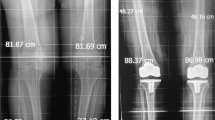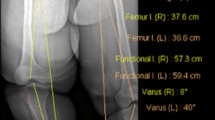Abstract
Purpose
The purpose of the study is to provide a methodology to quantify knee height asymmetry (KHA) and to establish the incidence of knee height asymmetry in a patient population visiting the limb length discrepancy clinic in a paediatric-orthopaedic hospital centre.
Method
A retrospective chart review was performed on all patients who attended the limb length discrepancy clinic and underwent corrective surgery at the Shriners Hospital for Children-Canada from December 2009 to December 2015. Full-standing anteroposterior radiographs were used to measure pre- and post-surgery limb length discrepancy and knee height asymmetry for 52 individuals included in the study.
Results
Sixty-seven percent of the studied population had a KHA of 20 mm or less, 25% had a KHA between 20 and 40 mm, and 8% had a KHA of over 40 mm. The average KHA preoperatively for all 52 individuals was 17 ± 14 mm (range 0–59 mm), which represents roughly 2.5% of total limb length. There was a 3-mm non-significant reduction in KHA size between pre-and post-operative states (p = 0.22).
Conclusion
The current study provides a method to quantify knee height asymmetry. Using this method, it was shown that knee height asymmetry is frequent in youth with limb length discrepancy in both pre- and post-corrective surgery states. The relatively high incidence of knee height asymmetry highlights the importance to investigate the impact of knee height asymmetry in youth living with a limb length discrepancy.





Similar content being viewed by others
References
Subotnick SI (1981) Limb length discrepancies of the lower extremity (the short leg syndrome). J Orthop Sports Phys Ther 3(1):11–16
Woerman AL, Binder-Macleod SA (1984) Leg length discrepancy assessment: accuracy and precision in five clinical methods of evaluation. J Orthop Sports Phys Ther. 5(5):230–239
Guichet JM, Spivak JM, Trouilloud P, Grammont PM. Lower limb-length discrepancy. An epidemiologic study. Clin Orthop Relat Res 1991(272):235-41
Escott BG, Kelley SP (2012) Management of traumatic physical growth arrest. Orthop Trauma 26(3):200–211
Stanitski DF (1999) Limb-length inequality: assessment and treatment options. J Am Acad Orthop Surg 7(3):143–153
Sushko J, Honeycutt C, Reed KB, editors. Prosthesis design based on an asymmetric passive dynamic walker. Biomedical Robotics and Biomechatronics (BioRob), 2012 4th IEEE RAS & EMBS International Conference on; 2012: IEEE
Zhang C, Dai W, Yang Y, Tang Q, Yao Z (2013) Melorheostosis and a review of the literature in China. Intractable Rare Dis Res 2(2):51–54
Luo CF (2004) Reference axes for reconstruction of the knee. Knee 11(4):251–257
Gurney B (2002) Leg length discrepancy. Gait Posture 15(2):195–206
Veilleux LN, Dahan-Oliel N, Pouliot-Laforte A, Parent A, Alotaibi M, Ballaz L, et al. The effect of a knee-height asymmetry on gait patterns and physical parameters in two patients with a corrected leg-length discrepancy. Gait Posture; 2016/09/01/2016. p. 248
Smith AJ, Lloyd DG, Wood DJ (2004) Pre-surgery knee joint loading patterns during walking predict the presence and severity of anterior knee pain after total knee arthroplasty. J Orthop Res 22(2):260–266
Jaspers E, Verhaegen A, Geens F, Van Campenhout A, Desloovere K, Molenaers G (2013) Lower limb functioning and its impact on quality of life in ambulatory children with cerebral palsy. Eur J Paediatr Neurol 17(6):561–567
Rosen S, Tucker CA, Lee SC (2006) Gait energy efficiency in children with cerebral palsy. Conf Proc Ann Int Conf IEEE Eng Med Biol Soc IEEE Eng Med Biol Soc Conf 1:1220–1223
Bhave A, Paley D, Herzenberg JE (1999) Improvement in gait parameters after lengthening for the treatment of limb-length discrepancy. J Bone Joint Surg Am 81(4):529–534
Braun BJ, Veith NT, Rollmann M, Orth M, Fritz T, Herath SC et al (2017) Weight-bearing recommendations after operative fracture treatment-fact or fiction? Gait results with and feasibility of a dynamic, continuous pedobarography insole. Int Orthop 41(8):1507–1512
Montpetit K, Hamdy RC, Dahan-Oliel N, Zhang X, Narayanan UG (2009) Measurement of health-related quality of life in children undergoing external fixator treatment for lower limb deformities. J Pediatr Orthop 29(8):920–926
Moraal JM, Elzinga-Plomp A, Jongmans MJ, Roermund PM, Flikweert PE, Castelein RM et al (2009) Long-term psychosocial functioning after Ilizarov limb lengthening during childhood. Acta Orthop 80(6):704–710
Handzic I, Reed KB (2015) Perception of gait patterns that deviate from normal and symmetric biped locomotion. Front Psychol 6:199
Escott BG, Ravi B, Weathermon AC, Acharya J, Gordon CL, Babyn PS et al (2013) EOS low-dose radiography: a reliable and accurate upright assessment of lower-limb lengths. J Bone Joint Surg Am 95(23):e1831–e1837
Agarwal A, Kumar A (2016) Fibula regeneration following non-vascularized graft harvest in children. Int Orthop 40(10):2191–2197
Deleanu B, Prejbeanu R, Crisan D, Predescu V, Popa I, Poenaru DV (2015) Gait characteristics before hardware removal in patients operated upon for tibial plateau fractures. Int Orthop 39(7):1411–1415
Acknowledgements
We appreciate the contribution of physiotherapists Monica Chan, Gloria Thevasagayam, and Rochelle Rein for the clinical feedback, as well as Kathleen Montpetit, MSc, OT, from the Shriners Hospitals for Children-Canada for the assistance with ethics submission. We are indebted to Mark Lepik (Shriners Hospital for Children-Canada) for the preparation of the figures and tables.
Author information
Authors and Affiliations
Corresponding author
Ethics declarations
Conflict of interest
The authors declare that they have no conflict of interest.
Ethical approval
For this type of study, formal consent is not required.
Rights and permissions
About this article
Cite this article
Veilleux, LN., AlOtaibi, M., Dahan-Oliel, N. et al. Incidence of knee height asymmetry in a paediatric population of corrected leg length discrepancy: a retrospective chart review study. International Orthopaedics (SICOT) 42, 1979–1985 (2018). https://doi.org/10.1007/s00264-018-3794-1
Received:
Accepted:
Published:
Issue Date:
DOI: https://doi.org/10.1007/s00264-018-3794-1




